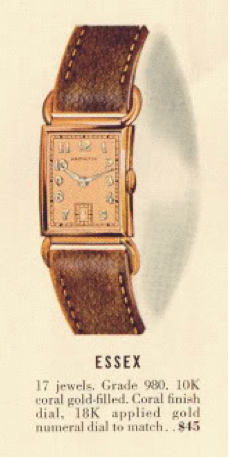1940 Hamilton Essex | Restoration
Share

Hamilton produced the coral gold Essex, now known more commonly as rose gold, from 1940 through 1941. The coral color is a gold and copper alloy, which is likely why it was only used for two years; Copper was needed to help with the war effort.

As received, this Essex was in pretty good shape. Because of the shape and position of the fixed wire lugs, it's not uncommon to find plate ware on the reverse side.

Power comes from the venerable caliber 980, a 17 jewel manual wind movement, made in Lancaster, PA. Even though it isn't running, the movement looks pretty clean.

After removing the train wheel bridge, a big ol' glob of dried lubricant shows up. This is actually a good sign. It probably means the watch isn't running because the lubricants failed over time, not because of a broken part. Only way to find out is to continue on into the watch.

Still more good news as more and more dried and gummy lubricant is found fouling the jewels of the power train...

...and on the balance cap jewel.

Another very common fault in watches from the 1940's, especially those that haven't been serviced previously, is a 'set' steel mainspring. These older mainsprings were made from a spring steel that, over time, would 'set', or take on the shape of the barrel it was wound into. This would sap the watch of its power reserve and would need to be replaced with a white allow mainspring.

After a thorough cleaning in the heated ultrasonic bath, reassembly can commence. The jewels are all now bright and shiny.


To replace the old set steel mainspring, I dug out a NOS white allow mainspring. These mainsprings are far more resistant to setting and were marketed as 'Lifetime' mainsprings originally.

Here the difference between the two mainsprings can be seen.

With the watch back together and running, the jewels are lubricated once again, this time using modern oils.

The previous crystal was too far gone for me to save it, so I'll install a NOS acrylic crystal.

After a quick buffing of the case to shine everything up, a thin bead of adhesive is applied along the inside edge of the bezel. The crystal is then pressed into place and the adhesive is allowed to dry overnight.

With a strap added (and yes, the strap goes OVER the lugs), this watch is ready to impress once again.
